Public art installations elevate community pride while sharing local history and identity with visitors from across Iowa
Community-engaged residency partners student artists with communities while producing the next generation of public artists
Maura Pilcher is the director of the Grant Wood Art Colony (GWAC), which celebrates the life and legacy of Iowa's most famous artist, Grant Wood. Each year, the Colony provides three Fellowships in Painting & Drawing, Printmaking, and Interdisciplinary Performance in addition to hosting a biennial symposium and supporting community-engaged art partnerships with Arts Share and the Office of Community Engagement (OCE).
The history of community-engaged art at the University of Iowa (UI) begins with Grant Wood, who came to the university as part of the Public Works of Art Program in 1934.
"He had just completed American Gothic, which was all the rage at the time," Pilcher said. "When he was here, he worked on many murals and public art projects with university students, which made our community-engaged art residency and fellowship programs a good fit for GWAC, whose goal is to continue the life and legacy of Grant Wood."
Annual GWAC fellows stay at the UI for one year, teaching students, holding workshops, and bringing art programs to Iowa communities.
"Our fellows are only here for a year, which doesn't allow for deep engagement in a community," Pilcher said. "We have long-term connections with communities, but our fellows only get to do these little touches across Iowa. We needed a different way to ensure we participated in our mission's engagement component."
In response to the demand from communities across Iowa for sustained public art partnerships, GWAC and Arts Share came together within the OCE to create opportunities for UI students to bring their creativity and vision to public art installations that uplift the identity of local towns and cities while reflecting the values and history which define them.
The process began with a symposium in 2018 called Art in Public, where educators, artists, and working professionals - from lawyers to urban and regional planners – came to campus to talk about what art in public spaces means from practitioner and organizational perspectives along with how to create a program to teach the next generation of community-engaged artists at the university.
Following the symposium, GWAC held a public art residency, training nine UI undergrads and graduate students during a weeklong intensive. The following summer, students partnered with Iowa communities to create artwork in public spaces.
"That first residency in 2019 gave us a great batch of artists to start working with," Pilcher said. “When we get a request from a community who is interested in forming a partnership, we put a call out to our artists who have been trained and know how to work with communities, apply painting techniques, and understand the nuts and bolts from theory and presentation."
In 2023, the Arts as Community Engagement Workshop began to train additional UI artists to partner with Iowa communities on public art projects.
IMPACTING COMMUNITY EXPERIENCES
One of the first community-engaged art partnerships that formed was between the Iowa Initiative for Sustainable Communities and Cedar County, Iowa, exploring the potential for a grant to fund a student video and public art project. Although the funding didn't come through, it did lead to a mural program focused on placemaking in communities.
"One of the Cedar County administrators was a strong believer that he wanted to get people off the interstate to travel through the county and check off these postcard murals as they drove through," Pilcher said. "As part of the residency, students met with local stakeholders, visited the towns, and created concept drawings that they presented to community members."
In response, multiple communities in Cedar County decided to move forward with a mural, including Stanwood, Mechanicsville, Tipton, and Lowden.
"Of the seven communities we had initially done, four are already up," Pilcher said. "I was at a City Hall meeting at West Branch, and one of the board members said, 'I just drove through Stanwood, and I want that in our community.' It was so great and affirming to hear that she was excited by how the students' art represented Stanwood."
Lowden, Iowa, was one of those communities looking to create an art installation to represent the community while attracting visitors.
"The front of our town was bland and uninviting, and we were looking for inspiration to attract new residents and visitors to our community," said Lowden City Clerk Sarah Carlson.
Despite having a large park, golf course, hotel, and restaurants to greet visitors, Lowden wanted to add more character to the entrance of the town off Highway 30.
"After much debate and community input, the city embarked on a mission to make a mural as visible as possible," Carlson said. "The final location we chose was a little unconventional but has had a big impact."
Lowden wanted to put a large mural on a fertilizer tank visible from the highway and worked with the UI to secure an artist to help capture the town's vision.
"The process was straightforward, and we met with the artist [Katlynne Underhill] on several occasions to discuss our needs," Carlson said. "The artist was very professional and inspired our residents with ideas and storyboards to help us decide on a postcard theme."
Since completing the installation, Lowden has received many compliments regarding the mural from new and existing residents, including visitors from other local communities.
"The City of Lowden chose the university program, and the artist who made the town's vision come to life and the finished product was amazing," Carlson said. "The impact to our community is one of pride and will continue to represent our town for years to come."
Another partnership between student artists and a local community partner involved bringing many types of arts experiences beyond just installations, working with the Maquoketa Art Experience (MAE), a nonprofit gallery established in 2008 by a group of community artists and individuals interested in the arts.
"MAE was spear-headed by Robert (Bob) Osterhaus, an art enthusiast, who saw the communities need for exposure to the arts which would also benefit the economy of the area as a cultural destination," said Nancy Kilburg, Educational Liaison with Maquoketa art Experience. "Maquoketa is located within Jackson County and is a depressed economic rural area in Iowa which has lacked the availability of 'affordable' fine art and performance arts. Residents frequently travel to cities outside the area or state to avail themselves of cultural experiences or do not experience them."
Artists from the university brought art exhibits, discussions, workshops, demonstrations, instrumental and vocal performances, stage and musical theater, jazz, and music in nature, expression and writing, dance, and opera to Maquoketa as part of their community-engaged arts emphasis.
"The partnership with the University of Iowa's community-engaged art program continues to be invaluable to Maquoketa and Jackson County," Kilburg said. "These programs have brought to our community opportunities to experience the diverse talents of gifted artists
through programs that support and sustain MAE's vision."
BRINGING COMMUNITY IDENTITY TO LIFE
Student artists begin the process by visiting towns interested in forming a partnership to explore potential project ideas while getting a sense of place to help guide their vision in putting together a piece that represents the richness and history unique to each community.

"Every time I take students into communities, they see Iowa differently," Pilcher said. "They are seeing these towns and bringing new ideas, and it is exciting to watch students talk to community partners with such excitement and enthusiasm. Our artists come in and see the wonderful things taking place through a unique lens, and they can articulate that vision artistically."
Alexis Buclear, a member of the residency program, created murals in Mechanicsville, Stanwood, and on the back of Kambucha Café in Iowa City.
"These works are truly an example of her self-expression," Pilcher said. "She had no limits on what she could put on the back of that building, but you can see how she took that style and color scheme and put it into Stanwood and Mechanicsville mural in a way that still reflects the community but has passed through her lens."
Community partners receive art installations they never would have thought to ask for while having the opportunity to assist student artists with bringing their vision to life.
"Kids and adults painted the murals with Alexis, participating in the beautification of their community while having a special experience," Pilcher said. "The towns then start to see through the artist's lens - and it is a refreshing lens - which exemplifies their history, and people love it. That happens all the time when our artists go into communities."
Several residency attendees continue to work in local communities, despite not being from Iowa when they began as students.
"It's not only a great thing for our students to go on and become professional artists, but a great thing for the state of Iowa to have these wonderful, talented people choose to stay and invest in our state," Pilcher said. "I think of it as a RAGBRAI situation where people end up in small towns and fall in love. It's a mutually beneficial experience."
IMPACTING STUDENT EXPERIENCES
Students enter the residency program with different levels of ability, many of whom have sharpened their skills and gone on to find continued success with community-engaged art.
"We do have success stories for sure," Pilcher said. "Ali Hval is a big one we talk about frequently. She went through the residency, found great value in it, and learned the nuts and bolts and right products to use, which enhanced her practice."
During her time as a graduate student at the University of Iowa in Painting and Drawing, a fellow graduate student working on a mural project through the residency program asked Hval to assist, which led her to complete the project when the initial artist was unable to.
"My run into the Office of Community Engagement was a happy accident," Hval said. "Although a bit terrifying, I was also excited to try mural painting and see what it did for my studio practice. The project ended up being a success, and I continued to work with the Office of Community Engagement on public art projects during my time at Iowa."
Through her connection with the OCE, Hval traveled to communities such as Mason City, Clinton, and Webster City and received guidance and funding for creating murals for those communities.
"I learned the importance of involving locals in decision-making, how to work through the design process, and specific steps to mural implementation," Hval said. "I also learned how to create a budget and what equipment and supplies would be necessary for a specific project, which jumpstarted my career in mural painting."
By the time Hval graduated in 2019, she already had numerous murals to serve as a portfolio of work to point to when applying for new opportunities.
"Without the guidance and opportunities from the Office of Community Engagement, I wouldn't be where I am today," Hval said. "I also never expected to be able to make money from doing something I love - painting and creating."
Hval graduated from the UI, choosing to stay in Iowa to continue creating art, and is now a visiting assistant professor at the University of Iowa School of Art and Art History. She has a robust practice creating murals across Iowa, including several in Cedar Rapids.
"Now, I have completed over 40 public art projects in Iowa, as well as a few others outside the state in Florida, Alabama, and Arkansas," Hval said. "This mural work is slowly seeping into the personal studio work I make as well, especially in scale and installation. I hope to continue expanding my breadth of mural work across the U.S. and can't wait to see where it takes me!"
Drew Etienne is another residency participant who created public art in Indiana before coming to the UI for his Master of Fine Arts degree.
"I'm so glad I decided to apply for the Grant Wood Public Art Residency in 2019," Etienne said. "I learned more about the theory and practice of public art in that one week than I had in the handful of years I'd been doing it on my own. It was an intense but very fruitful week. I also developed many lasting relationships through being a part of that group. I'm thankful to have made new friends, and I think it's also been crucial in our mutual growth as working artists."
During his residency, Etienne had many opportunities to work with different communities and discuss their history, what makes them proud of their hometown, and their hopes and aspirations for their community's growth and progress.
"What I learned at the residency helped form the core of how I consider what my role is in making public work - both as a citizen and as a career artist," Etienne said. "Artists are practiced at visualizing things that may be philosophically abstract, difficult to represent, or hard to grasp. Communicating successfully and understanding and conveying a community's goals is as important as creative decision-making and artistic ability, and it's vital in creating work that can remain relevant and relatable through the years."
Etienne has continued to put the knowledge he gained into practice while consistently improving his work in the field, gradually developing his art practice into a more sustainable source of income, which has encouraged him to think creatively about other ways to engage in similar work. He continues to make murals and public art, including a piece on the side of Joe's Tavern and the Graduate Hotel in Iowa City.
OPPORTUNITIES TO GET INVOLVED
Participating in the community-engaged art residency helps student artists learn how to partner with communities and start receiving competitive commissions. The experience also enhances their reputation through the amount of work they complete while students.

"Which is a huge endorsement," Pilcher said. "Here is a portfolio of all their public art projects. You can't do that in a studio, you must be accepted and allowed to put work up on walls. Having that as part of a portfolio is a wonderful opportunity."
UI undergraduate and graduate students interested in community-engaged art are welcome to contact the OCE or GWAC to explore training opportunities, including the Arts as Community Engagement Workshop, even if they have yet to gain prior experience creating public art installations.
"We understand there are artists who come in who have had a great experience with it already," Pilcher said. "But we also want all students to do this work if they are able and have the skillset and talent to do so. We want to support and help them."
Communities considering public art projects are also encouraged to reach out. Partnerships are a financially accessible way to bring installations to local towns with student artists guided by UI resources and faculty who will help with communication, production, and meeting expectations.
"We have people in our network of UI professionals who will help with materials, prep, and answering all those little questions that you only get through the experience," Pilcher said. "While you are working with the student and getting their wonderful creativity and paying them, you are also getting the university resources behind the artist, which greatly benefits communities."
Story by James Dykeman
